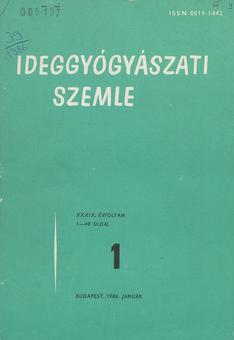The eLitMed.hu medical portal uses computer cookies for convenient operation. Detailed information can be found in the Cookie-policy.
Clinical Neuroscience - 1986;39(01)
Content
[Glial fibrillary acidic protein in human anaplastic astrocytoma transplanted into Nude mice]
[We investigated the behaviour of glial fibrillary acidic protein (GFAP) in a Nude mouse transplanted tumour of an anaplastic astrocytoma in a 33-year-old woman. The proportion and nature of cells containing the protein, detectable by immunoperoxidase reaction, showed a high degree of similarity to the original tumour and the tumour was shown to be safely maintained by further transplants in the six months since the first transplantation. For the characterisation of glia-derived tumours of the central nervous system, the described procedure seems promising. GFAP detection is a tumour marker that may have diagnostic significance in the histogenesis of CNS tumours. This property was also retained by the brain tumour we studied in Nude mouse transplants.]
[Myasthenia gravis: total lactic acid dehydrogenase (LDH) activity and LDH isoenzyme distribution in hyperplastic thymus and thymic tumors]
[The authors determined the total lactic dehydrogenase (LDH) and malic dehydrogenase (MDH) activity per wet weight and the percentage distribution of LDH isoenzymes in 55 hyperplastic and 7 tumorous thymuses removed by thymectomy from 62 patients with myasthenia gravis, and calculated the MDH/LDH ratio and the percentage of H subunit. The increase in total LDH and MDH activity suggests that the thymus of myasthenic patients is richer in cellular elements compared to control, and the increase in LDHi isoenzyme and H subunit indicates an increase in the proportion of more mature, differentiated thymocytes. The thymic tumours showed an isoenzyme distribution dominated by LDH5 or LDH4, typical of tumours in general, except for thymomas with minimal lymphocytic response, where an isolated, marked increase in LDH2 isoenzyme is thought to indicate specific (secretory) epithelial cell function. The H subunit ratio, as a parameter characterising both lymphatic and epithelial components of the thymus, showed a strong correlation with certain clinical data (prognosis, disease duration, treatment), with a decrease being a favourable prognostic sign and an increase an unfavourable one. An increase in total LDH activity and a decrease in the MDH/LDH ratio were associated with clinical malignancy of tumours. Their studies may be useful in planning further treatment of myasthenia patients who do not improve adequately after thymectomy.]
[Our experience in group therapy and group hypnotherapy for renal patients with azotemia]
[The authors emphasise the importance of increased care for patients with chronic renal failure, and argue that complex psychosomatic treatment helps them more than somatic nephrological care alone. To prove this, a pilot group of 11 patients with chronic renal failure received regular group therapy and group hypnotherapy sessions for one year; data from 9 patients with similar stages were used as controls. The patients' cooperation in adhering to both the recommended diet and fluid intake improved markedly. Of the 11 patients in the experimental group, 10 became fit for work, while the proportion of those unable to work doubled in the control group. The number of hospital days was reduced by a third with the help of group therapy. Patients in the experimental group are on dialysis later: complex psychotherapy helps to prolong the stage of compensatory polyuria. Hypnotherapy has also been shown to have a significant hypotensive effect. Their method is considered to be effective in the psychological preparation phase of the dialysis programme and their wider adoption is recommended.]
[Surgery for peduncular haemorrhage from arteriovenous angioma]
[The authors successfully surgically removed bleeding from an arteriovenous angioma in the left pedunculus of a young female patient. They point out that relatively small brainstem haemorrhages can be successfully treated surgically in young individuals. With advancing age both timely diagnosis and the possibility of surgical treatment are reduced.]
[Scanning electron microscopic study of sclerotic plaques of carotid bifurcation]
[The authors report a scanning electron microscopic study of 24 hemispheric symptomatic proximal carotid plaques. Angiography was used to smooth sclerotic plaque was found to be smooth-surfaced and several lesions were detected that are thought to be the source of embolism. Therefore, surgical removal of symptomatic sclerotic plaques that do not cause significant haemodynamic stenosis is also considered justified.]
[Report on the 13th International Bálint Meeting]
[The meeting, which has been organised for the 13th year in a row by Professor Boris Luban-Plozza, was attended by four Hungarian participants (Gábor Petri, János Szilárd, Endre Sehnell and Géza Orián), in addition to experts from Switzerland, the Czech Republic, Austria, Italy and a few other countries.]
1.
Clinical Neuroscience
[Headache registry in Szeged: Experiences regarding to migraine patients]2.
Clinical Neuroscience
[The new target population of stroke awareness campaign: Kindergarten students ]3.
Clinical Neuroscience
Is there any difference in mortality rates of atrial fibrillation detected before or after ischemic stroke?4.
Clinical Neuroscience
Factors influencing the level of stigma in Parkinson’s disease in western Turkey5.
Clinical Neuroscience
[The effects of demographic and clinical factors on the severity of poststroke aphasia]1.
2.
3.
4.
5.



